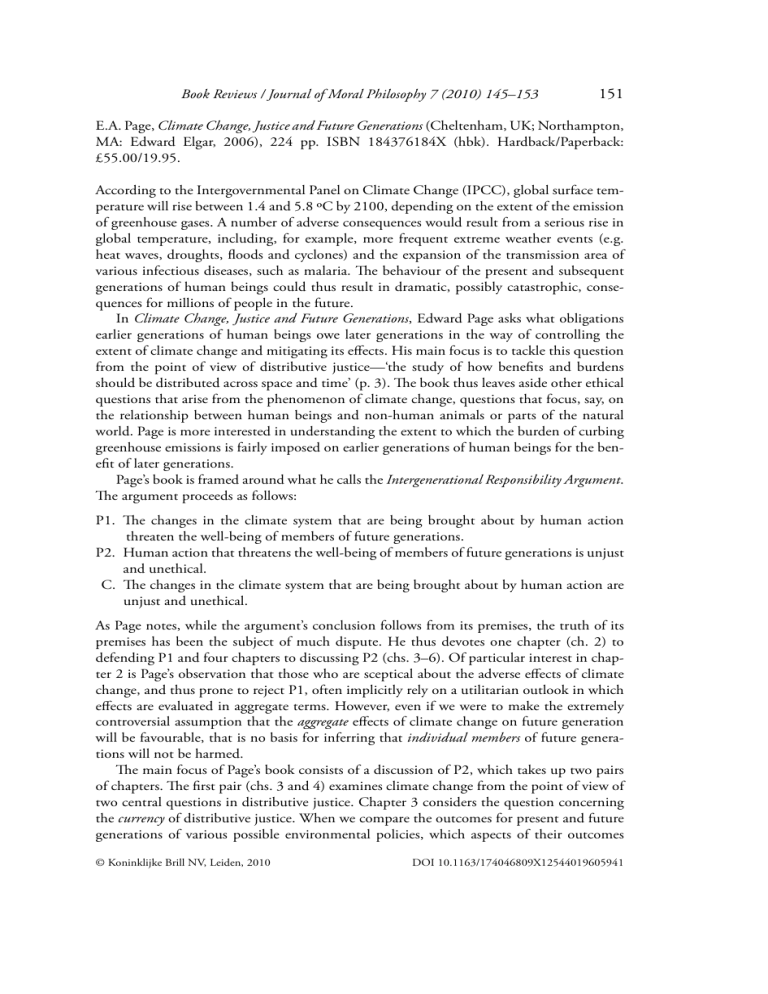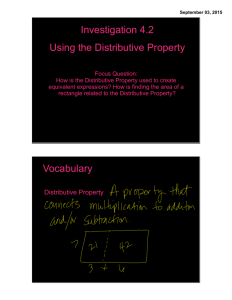151
advertisement

Book Reviews / Journal of Moral Philosophy 7 (2010) 145–153 151 E.A. Page, Climate Change, Justice and Future Generations (Cheltenham, UK; Northampton, MA: Edward Elgar, 2006), 224 pp. ISBN 184376184X (hbk). Hardback/Paperback: £55.00/19.95. According to the Intergovernmental Panel on Climate Change (IPCC), global surface temperature will rise between 1.4 and 5.8 ºC by 2100, depending on the extent of the emission of greenhouse gases. A number of adverse consequences would result from a serious rise in global temperature, including, for example, more frequent extreme weather events (e.g. heat waves, droughts, floods and cyclones) and the expansion of the transmission area of various infectious diseases, such as malaria. The behaviour of the present and subsequent generations of human beings could thus result in dramatic, possibly catastrophic, consequences for millions of people in the future. In Climate Change, Justice and Future Generations, Edward Page asks what obligations earlier generations of human beings owe later generations in the way of controlling the extent of climate change and mitigating its effects. His main focus is to tackle this question from the point of view of distributive justice—‘the study of how benefits and burdens should be distributed across space and time’ (p. 3). The book thus leaves aside other ethical questions that arise from the phenomenon of climate change, questions that focus, say, on the relationship between human beings and non-human animals or parts of the natural world. Page is more interested in understanding the extent to which the burden of curbing greenhouse emissions is fairly imposed on earlier generations of human beings for the benefit of later generations. Page’s book is framed around what he calls the Intergenerational Responsibility Argument. The argument proceeds as follows: P1. The changes in the climate system that are being brought about by human action threaten the well-being of members of future generations. P2. Human action that threatens the well-being of members of future generations is unjust and unethical. C. The changes in the climate system that are being brought about by human action are unjust and unethical. As Page notes, while the argument’s conclusion follows from its premises, the truth of its premises has been the subject of much dispute. He thus devotes one chapter (ch. 2) to defending P1 and four chapters to discussing P2 (chs. 3–6). Of particular interest in chapter 2 is Page’s observation that those who are sceptical about the adverse effects of climate change, and thus prone to reject P1, often implicitly rely on a utilitarian outlook in which effects are evaluated in aggregate terms. However, even if we were to make the extremely controversial assumption that the aggregate effects of climate change on future generation will be favourable, that is no basis for inferring that individual members of future generations will not be harmed. The main focus of Page’s book consists of a discussion of P2, which takes up two pairs of chapters. The first pair (chs. 3 and 4) examines climate change from the point of view of two central questions in distributive justice. Chapter 3 considers the question concerning the currency of distributive justice. When we compare the outcomes for present and future generations of various possible environmental policies, which aspects of their outcomes © Koninklijke Brill NV, Leiden, 2010 DOI 10.1163/174046809X12544019605941 152 Book Reviews / Journal of Moral Philosophy 7 (2010) 145–153 should occupy our moral concern? Should we compare their levels of welfare, the resources at their disposal, their capabilities to function in certain important respects, or some other aspect of their outcomes? Page sides with G.A. Cohen’s view that the relevant currency should be ‘access to advantage’, where this includes both resources and welfare. Chapter 4 considers the question concerning the profile of distributive justice. Should environmental policies focus on ensuring that present and future generations enjoy equal outcomes, or on giving priority to protecting those who are worse off, or on securing that as many people as possible have enough? Page does not commit to any one profile, but argues that different profiles may be suitable for different contexts. The second pair of chapters (chs. 5 and 6) discusses two problems that arise for supporters of P2. Chapter 5 examines what Page calls the non-reciprocity problem. For many commentators, distributive justice revolves around, and depends on, relationships of reciprocity between people in which they cooperate for the production of mutual benefits. However, a reciprocity-based view of distributive justice cannot account for obligations of justice between an existing generation and a future, unborn generation of people, since the latter obviously cannot engage in the kinds of cooperation involved in a relationship of reciprocity. Chapter 6 discusses the so-called non-identity problem, which revolves around the fact that future people may depend for their existence on the harmful environmental conduct of earlier generations. Since those future people would not have existed without that conduct, they cannot be said to be made worse off as a result of it than they otherwise would have been. It is thus unclear in what sense that conduct can actually be said to have harmed them. Page’s discussions of these various complex issues have several appealing features. First, they are extremely clear and accessible. Readers who come to this book with no background in political theory or moral philosophy will be able to follow some very intricate moral arguments about climate change. Secondly, Page consistently maintains a balanced and fair-minded approach to the evaluation of arguments about climate change, arguments which, given their enormous significance, might have tempted others into taking a more dogmatic or polemical stance. Finally, the book is unfailing in its efforts to show the concrete relevance of the various moral arguments it discusses. The reader is kept abreast throughout of the implications for environmental policy of a particular objection or revision to the given argument under discussion. In sum, the book is a very instructive treatment of the moral implications of climate change. That being said, there are two points on which Page’s book might be open to criticism. The first concerns a structural problem. It is not always clear how some of the discussions in the book relate to the Intergenerational Responsibility Argument around which they are framed. One example is the discussion of the currency of distributive justice in chapter 3. Page motivates that discussion (as well as the profile discussion in chapter 4) by maintaining that ‘there have been few systematic attempts to test the robustness of premise P2… across different theories of distributive justice’ (p. 10)—P2, recall, being the premise that human action that threatens the well-being of members of future generations is unjust and unethical. Page doesn’t clearly show, however, why a discussion of the correct currency of distributive is necessary for evaluating the truth of P2. Whether or not it is true that it is unjust and unethical to harm future generations would not seem to depend on whether our preferred account of how people ought to be compared for the purposes of distributive Book Reviews / Journal of Moral Philosophy 7 (2010) 145–153 153 justice is that of welfare, resources or capabilities. P2 could be endorsed by a proponent of any of those three currencies. Another example is the discussion of the non-reciprocity problem in chapter 5. As Page notes in that chapter, while reciprocal relations between generations might be a necessary condition for one generation to owe positive duties to the other, such relations are not plausibly regarded as necessary in order for there to exist a negative duty not to harm the other. But if that is the case, then it is unclear why the non-reciprocity problem really is a problem for anyone who adopts P2, since that premise only maintains that it is unjust for one generation to harm the well-being of another. The non-reciprocity would be a problem for P2, it seems, only if P2 asserted that it is unjust for one generation not to benefit a future generation. The second criticism one might level against the book is that it might have struck a balance more in favour of developing its original contributions to the moral debate on climate change, and less on rehearsing arguments and objections within distributive justice that are by now already familiar. The arguments made in chapters 3 and 4 on the currency and profile of distributive justice, for example, are not new. On the other hand, the most original part of the book, where Page proposes a solution to the non-identity problem, might have been extended a little further. Page’s solution to the non-identity problem is to suggest that although it may be true that future individuals cannot be said to be harmed by negligent environmental policies that were a precondition for their existence, future communities of individuals can be said to be harmed by such policies. Page gives the following hypothetical example: imagine a Pacific island community that has had to abandon its island and its culture because of the cumulative effects of human-caused climate change. Even if it is the case that the individual members of that community might not have existed but for the policies that brought about that change, the community would have existed and so it, the community, can be said to have been harmed (assuming, plausibly, that its destruction has made it worse off than it would have been). If we think at the level of communities rather than individuals, we may, then, be able to condemn environmentally negligent policies despite the non-identity problem. That is an interesting argument, but Page might have devoted more time to developing it further. One question, for example, is the basis on which one might identify the relevant community interests that could be harmed by the environmental policies of previous generations. The destruction of the Pacific island community obviously harms that community, but how might we identify cases in which communities are harmed, apart from the case of total destruction? Answering that question is important because unless Page’s proposal were to apply to cases beyond the total destruction of a community, it is questionable whether it really solves the non-identity problem, as opposed to identifying a small area of cases in which that problem can be avoided. Paul Bou-Habib University of Essex pbou@essex.ac.uk





